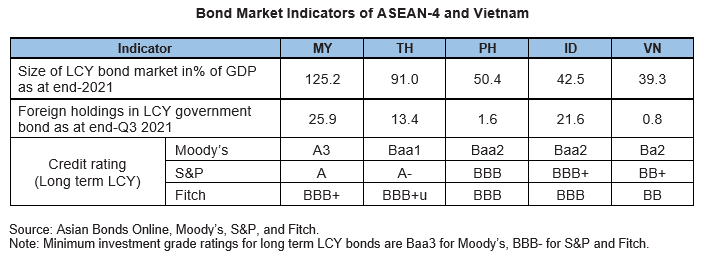Bond market development and integration with international capital markets are hallmarks of economic growth. As Vietnam firmly establishes itself in the group of middle-income countries, access to concessional financing from international financial institutions and bilaterals will progressively decline. To replace these sources of financing, it will be essential for Vietnam to develop and access other sources to meet its significant infrastructure and development needs.

Compared to its regional peers, Vietnam needs to further develop its bond market. The volume of outstanding bonds in Vietnam was around 39.3 percent of GDP at end-2021, with treasury bonds accounting for more than 50 percent. Investors are primarily local; foreign investors held less than one percent of the total local currency government bonds outstanding. Corporate bond issuers are less diversified and dominated by real-estate developers and commercial banks. Reflecting the nascent market, Vietnam’s sovereign credit rating of the government bonds is also lower than regional peers. The credit rating has been upgraded gradually since 2013 but remains below investment grade.

Raising the sovereign rating is essential to enhance access to global financial markets and reduce the cost of capital. Looking ahead, it is expected that the country will increasingly access international capital markets to supplement domestic sources to meet growth and development financing needs.
In this regard, in May 2022, the Prime Minister, Phạm Minh Chính, approved Decision No. 412/QD-TTg which aims to improve the sovereign rating to investment grade by 2030. To achieve this goal, a reform agenda is in place. Among the key elements of this agenda are:
- Growth: Achieving 7-percent average annual real GDP growth during 2022-2030, GDP per capita of USD7,500 by 2030, and capital investment accounting for 33-35 percent of GDP.
- Fiscal sustainability: Keeping budget deficit within 3 percent of GDP; public debt-to-GDP ratio within 60 percent, and government debt-to-GDP ratio of 50 percent by 2030.
- International reserves and banking sector: foreign exchange reserves worth at least 16 weeks (roughly 4 months) of goods and services imports; capital adequacy ratio of local commercial banks of 11-12 percent during 2021-2025 and at least 12 percent thereafter; maintaining banking system equity to asset ratio of at least 9 percent.
- Social and environmental targets: achieve 0.7 or above of the UNDP Human Development Index, a 42-percent forest cover rate; and 70 percent or higher rate of treatment and reuse of wastewater into the river basin.
While Vietnam had made great strides in its economic development, the country will increasingly need access to international financial markets to finance its development projects. This will require a concerted effort to implement a range of reforms, including to deepen financial markets and enhance the country’s sovereign rating.
